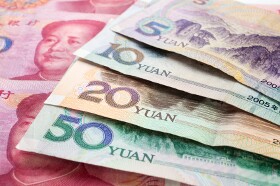The Chinese yuan is weakening against major currency rivals on Thursday after new data painted a grim picture of the worldâs second-largest economy. The trade war, which appears to be at a standstill, is seeping to a whole host of areas in Beijing, impacting economic growth and causing officials to hit the panic button. In the backdrop of the chaos is the yuan nearing toward the 7 threshold against the buck.
According to the Ministry of Commerce, foreign direct investment (FDI) into China climbed at a sluggish pace of 1.3% to $53.34 billion between January and May. The biggest story, however, is that US investment in China advanced just 7.5% during this time, which is a lot slower than the 24.3% jump between January and April and 16.3% growth in American investment over the first five months of 2018.
New data from the China Association of Automobile Manufacturers (CAAM) found that automobile sales crumbled 16.4% in May from the previous year to 1.91 million units. This is the third time this year that vehicle sales slipped below two million units.
Chinese financial institutions seemed to have taken advantage of the lower reserve requirement ratio (RRR) because they increased their new loans last month. According to the Peopleâs Bank of China (PBOC), banks extended 1.18 trillion yuan in net new loans, up from 1.02 trillion in April. But it was lower than the market forecast of 1.225 trillion. Mortgages and corporate loans accounted for much of the new loans.
This development might have been supported by the 8.5% growth in the broad M2 money supply, which totaled 189.12 trillion yuan.
Investors will now wait for fixed asset investment, industrial output, and retail sales figures to finish the trading week. Manufacturing numbers will be on the docket next week.
Meanwhile, Chinese shoemakers are increasingly shifting their production to Indonesia as the trade war intensifies, says Bank Indonesia deputy governor Dody Budi Waluyo. In the first four months of 2019, Indonesia exported $560 million in footwear, up 6.7% from the same time a year ago. In 2018, footwear exports totaled 6.5% and 3.5% in 2017.
Vice Premier Liu He told a financial forum in Shanghai that the government needs to do more to support the economy, such as implementing greater stimulus measures and ensure sufficient liquidity in the market. He hinted that the federal government will unveil more policies to increase growth amid the trade war.
This comes one week after PBOC head Yi Gang said there was âtremendousâ room for monetary adjustments to bolster growth, whether it is cutting interest rates or reducing the RRR again.
Ministry of Commerce spokesperson Gao Deng told a press conference: “There will be no winner in the trade war, which could cause a recession in the United States and global economies.”
The USD/CNY currency pair rose 0.06% to 6.9217, from an opening of 6.9177, at 16:40 GMT on Thursday. The EUR/CNY edged up 0.02% to 7.8085, from an opening of 7.8066.
If you have any questions, comments, or opinions regarding the Chinese Yuan, feel free to post them using the commentary form below.
Chinese Yuan Weakens on Falling Auto Sales, Sluggish US Investment
